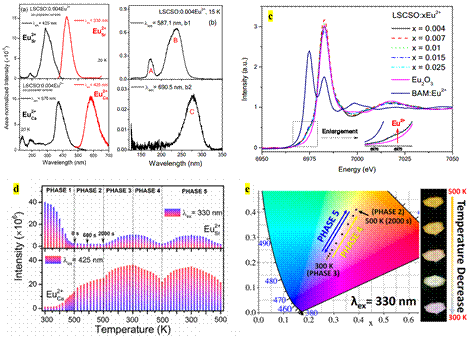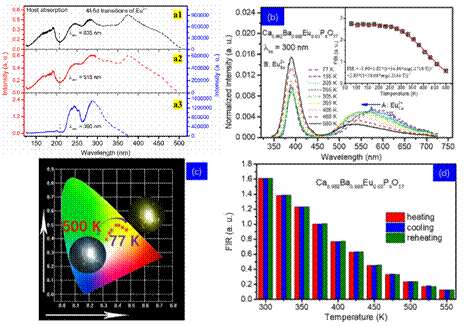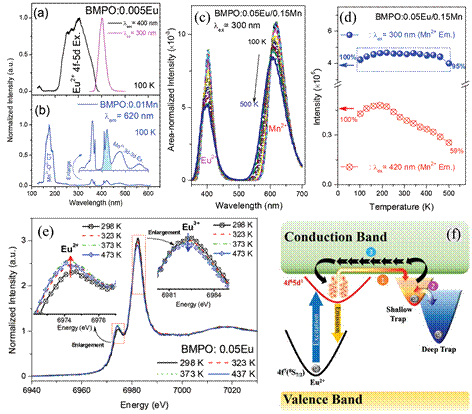| The site occupancies, energy transfer and temperature sensitivities of Eu2+ activated luminescent materials |
| From: PublishDate:2020-07-31 Hits: |
The optical thermometry based on lanthanide luminescence is generally realized by monitoring the ratio of temperature-dependent 4f-4f emission intensities arising from two “thermally coupled” 4f excited states in the system. Using the new strategy, the research group headed by Prof. Hongbin Liang of Sun Yat-sen University recently reported the site occupancies, energy transfer and temperature sensitivity of Eu2+ activated new luminescent materials, as well as their potential applications in optical thermometry. The basic idea of this novel strategy is by recording the difference in temperature-dependent 4f-5d luminescence intensities of Eu2+ at different sites in a multi-site inorganic compound, and one typical representative was the Eu2+-doped Li4SrCa(SiO4)2 material. The relevant work has been published in ACS Appl. Mater. Interfaces, 2019, 11, 9691-9695. In this work, the researchers found that the dopant Eu2+ ions could simultaneously replace the Sr2+ and Ca2+ sites in Li4SrCa(SiO4)2 material which possessed the different coordination environments. Photoluminescence properties of Eu2+-doped Li4SrCa(SiO4)2 were then investigated with excitation energies in the vacuum-ultraviolet (VUV) to ultraviolet (UV) range measured at BSRF (Beijing Synchrotron Radiation Facility) 4B8 experiment station, and the 4f-5d emission of Eu2+ in different sites were detected around 425 nm and 570 nm, respectively. Eu L3-edge XANES spectra of sample was collected at 1W2B station in BSRF, and the results demonstrated that a large amount of Eu3+ existed in the material. After the detailed spectroscopic analysis, they found that the dopant Eu3+ was preferably replaced the relatively small Ca2+ sites in the lattice, which was different with the preferable substitution of Eu2+ in Sr2+ sites. Temperature-dependent luminescence properties of Eu2+-doped material were subsequently studied, and a unique luminescence evolution of Eu2+ in the as-prepared sample was detected during the first heating phase. As temperature increased from RT to 500 K, the luminescence intensity of Eu2+ in Sr2+ sites rapidly decreased along with the significant increase of Eu2+ luminescence located in Ca2+ sites. Such the luminescence evolution could be only induced by the simultaneous action of UV illumination and thermal treatment. The researchers believed that this phenomenon was probably related to the anomalous electron transfer processes between Eu2+/Eu3+ located at different cationic sites in the system. Later, the emission spectra of illuminated sample were recorded at different temperatures, and the results indicated that the thermal quenching effect on luminescence of Eu2+ situated at Sr2+ sites was more significant than that of Eu2+ in Ca2+ sites, leading to an observable luminescence colour change from blue-white to yellow as temperature increased. Subsequent temperature cycling measurement further showed the excellent temperature sensing repeatability of studied material, which reflected a great applications potential of Eu2+-doped Li4SrCa(SiO4)2 in the optical thermometry field.
Figure 1. (a) Site-dependent VUV-vis excitation/emission spectra of the as-prepared Eu2+-doped Li4SrCa(SiO4)2 at 20 K; (b) site-dependent VUV-vis excitation spectra of Eu3+-doped Li4SrCa(SiO4)2 at 15 K; (c) Eu L3-edge XANES spectra of Li4SrCa(SiO4)2:xEu2+ (x = 0.004-0.025) at RT; (d) luminescence intensities of Eu2+ situated at Sr2+ and Ca2+ sites in Eu2+-doped Li4SrCa(SiO4)2 under 330 and 425 nm excitations in different temperature-variation phases; (e) CIE chromaticity coordinate changes of the sample under 330 nm illumination in PHASE 3-5 and the corresponding luminescence photographs. Later, they found that this strategy could be used in the design of other type of optical thermometric material, such as Eu2+-doped Ca6BaP4O17 compound. Experimental results demonstrated that this material also had a great potential for high-sensitive optical thermometry applications. The relevant work has been published in Chemical Engineering Journal, 2019, 369, 376-385.
Figure 2. (a) VUV-UV excitation spectra of Ca5.982Ba0.988Eu0.03P4O17 at 77K; (b) normalized emission spectra (λex=300nm) of Ca5.982Ba0.988Eu0.03P4O17 at 77–500K and the inset illustrates the temperature-dependent FIR values and the corresponding fitting result; (c) CIE chromaticity coordinates of Ca5.982Ba0.988Eu0.03P4O17 sample at 77–500K and corresponding images at 77 and 500K; (d) temperature-dependent FIR values of Ca5.982Ba0.988Eu0.03P4O17 sample in the temperature-cycling measurements. It was shown that the dopant Eu2+- could replace 12-coordinated Ba2+ sites, 8-coordinated Ca2+ (1) sites and 7-coordinated Ca2+(2) sites in Ca6BaP4O17 and the corresponding 4f-5d emissions were detected in UV, green and yellow wavelength regions, respectively. Low temperature VUV-UV excitation spectra of Eu2+ in different sites were then measured at 4B8 experiment station in BSRF. Based on these spectroscopic data, the impact degrees of crystal field splitting on 4f-5d transition properties of Eu2+ located at different sites as well as the substitution preference of Eu2+ in the system were obtained. Subsequently, the researchers investigated the energy transfer dynamics of different Eu2+ in Ca6BaP4O17 and discussed the concentration-dependent luminescence properties of studied materials. Temperature-dependent Eu2+ luminescence properties were then studied. It was showed that the thermal quenching effect on Eu2+ luminescence situated at two different Ca2+ sites was more significant than that of Eu2+ replaced Ba2+ sites, which was probably associated with the existence of “isolated” oxygen ions in the coordination environments of Ca2+ sites. Later, the researchers showed that the luminescence color of material could be tuned in a wide color coordinate range as temperature increased, demonstrating the application potential of Eu2+-doped Ca6BaP4O17 in optical thermometry. Besides that, this group also engaged in the investigation of the correlated relationship between luminescence properties of optical material and temperature. Generally, the increase in temperature induces the variation of local crystal structure of inorganic material and directly affect the photoluminescence performance of material. From the view of application, finding a way to maintain the luminescence intensity of optical material at different operation temperatures is one of the most difficult problems for researchers in this field. Recently, this group reported that a remarkable zero-thermal quenching of Mn2+ red luminescence was achieved in Eu2+-, Mn2+-codoped BMPO over a wide temperature range by successfully constructing a high-efficient Eu2+-Mn2+ energy transfer framework. The relevant work has been published in Adv. Optical Mater., 2019, 7, 1901187.
Figure 3. (a) Low-temperature VUV–UV normalized excitation/emission spectra of Eu2+-doped BaMgP2O7; (b) VUV–UV–vis normalized excitation spectrum of Mn2+-doped BaMgP2O7 at 100 K, with an enlarged view in the 300–600 nm region displayed in the inset; (c) temperature-dependent area-normalized emission spectra of BaMgP2O7:0.05Eu/0.15Mn under 300 nm excitation; (d) temperature dependences of Mn2+ emission intensities of BaMgP2O7:0.05Eu/0.15Mn upon 300 and 420 nm excitations; (e) in situ Eu L3-edge XANES spectra of BaMgP2O7:0.05Eu at elevated temperatures, with enlarged views of Eu2+ and Eu3+ absorption signals at different temperatures given in the insets; (f) schematic illustration of the mechanism for thermal-enhanced luminescence in Eu2+-doped BaMgP2O7. It was found that the thermal-induced luminescence enhancement of Eu2+ in the system was the key factor to cause the temperature-insensitive properties of Mn2+ 3d-3d luminescence in Eu2+ -Mn2+ codoped BaMgP2O7 material. The 4f/5d transition properties of Eu2+ and the relevant positionings of host valence band, conduction band and defect level in BaMgP2O7 was investigated in detail by employing the VUV-UV light source provided by 4B8 station in BSRF. Combining with the results obtained from other regular and synchrotron radiation-based spectroscopic techniques, the researchers gave a reasonable explanation on the phenomenon of thermal-induced luminescence enhancement of Eu2+, which created a strong foundation to comprehend the underlying nature of zero-thermal quenching of Mn2+ luminescence in the system. This work provided a feasible scheme for relieving the luminescence thermal quenching of optical materials and showed a guidance for relevant researchers to develop the luminescence materials with high temperature stability in the future. Article: Rui Shi, Lixin Ning,* Yan Huang, Ye Tao, Lirong Zheng, Zhibing Li, and Hongbin Liang*. Li4SrCa(SiO4)2:Eu2+: A Potential Temperature Sensor with Unique Optical Thermometric Properties. ACS Appl. Mater. Interfaces 2019, 11, 9691-9695. |
|
|
| Chinese
- Metal-free efficient photocatalyst for stable visible water splitting——Top ten major scientific progresses in China in 2015
- The nano-resolution imaging platform was awarded the first rate prize of Beijing Science and Technology in 2014
- Beamline 1W1 of BSRF started to runoperate in the couplingparasitic mode of BEPCII
- Synthesis of High Performance Polymer Materials for Field Effect-Transistors
- Surfactant molecular aggregates in green solvents
- GIXRD has played an important role in the characterization of organic thin-film transistors
Copyright © 2011 - 2012 Beijing Synchrotron Radiation Facility




